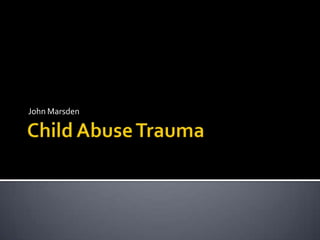
Effects of Child Abuse Trauma on Victims' Development
- 1. John Marsden
- 2. Briere, J. (1993) Child Abuse Trauma, London, Sage
- 3. Briere grouped the symptoms of child abuse trauma into seven categories: Post-traumatic Stress Cognitive Distortions Altered Emotionality Dissociation Impaired Self-reference Disturbed Relatedness Avoidance
- 4. Post Traumatic Stress Disorder (PTSD) can result from childhood abuse where there is the threat of death or intense fear (acute or chronic) Symptoms: Intrusive thoughts and/or nightmares Flashbacks Exaggerated startle response Avoidance Anger Depression Co-morbidity (alcohol/drug dependency)
- 5. Abuse that is violent may be experienced as life threatening Chronic abuse may also lead to PTSD Both acute and chronic abuse may be accompanied by intense fear Powerlessness and isolation are risk factors for PTSD. Perpetrators seek to isolate and control their victims.
- 6. Guilt Low-self-esteem Self-blame Impaired self-efficacy Abuse dichotomy – “bad people suffer, I am suffering therefore I must be bad”
- 7. Tactics of abusers include confusing the victim, undermining his or her self- confidence and decision making. Tactics also include shifting responsibility onto the victim Control of the victim and transgression of personal boundaries impacts on victim’s self- efficacy. Abuse may impair school performance and overall cognitive development
- 8. Anxiety Depression Suicidal thoughts Self-harming behaviour
- 9. Behaviour of the abuser and the sense/reality of being trapped results in “learned helplessness” or depression. Fearfulness and hyper-vigilance results from living in an abusive situation and results in anxiety disorders.
- 10. Disengagement – spacing out Detachment - numbing – of feelings Observation – watching self rather than participating Amnesia Dissociative Identity Disorder
- 11. Threatening situations which cannot be escaped must be endured. In order the endure what is intolerable individuals learn to dissociate, those who do not dissociate tend to develop PTSD. In extreme cases the individual “splits” into different personalities.
- 12. Sense of self as impaired leading to boundary issues, identity problems and feelings of personal emptiness.
- 13. One development task is the creation of “personal integrity” or boundaries between Self and Other. Perpetrators of abuse blur and abuse those boundaries. The victim experiences their personal integrity transient and dependent on others. In borderline personality disorder the individual struggles to contain his or her emotions, has a chaotic lifestyle and unstable relationships.
- 14. Inability to differentiate the needs of the self from the needs of others (co-dependency) Attachment issues, such as a fear of intimate and/or sexual relationships Inability to trust Inability to enjoy intimacy, including sexual intimacy
- 15. Abuse damages the victim’s trust in others Victims may avoid close relationships Sexual abusers “condition” sexual behaviour in victims by establishing a “token economy” of rewards and threats. Sexualised behaviour in childhood may lead to promiscuity in later life.
- 16. Avoidance of conflict Avoidance of sex and sexuality Avoidance of time and place Avoidance of triggers and associations (e.g. films and TV) The active maintenance of low self-esteem
- 17. Children avoid contact with the abuser and/or the abuse environment. Children avoid triggers and associations that remind them of the abusive experience Avoidance becomes an approach to managing threatening situations and negative emotions.
- 18. Age at onset of abuse Intrusiveness of the abuse Relationship with the abuser Use of Violence (level of violence) Female abuser Reaction of others on disclosure
- 19. Child abuse trauma has the potential to negatively shape a victim’s personality, his or her development, relationships and ways of being in the world .
